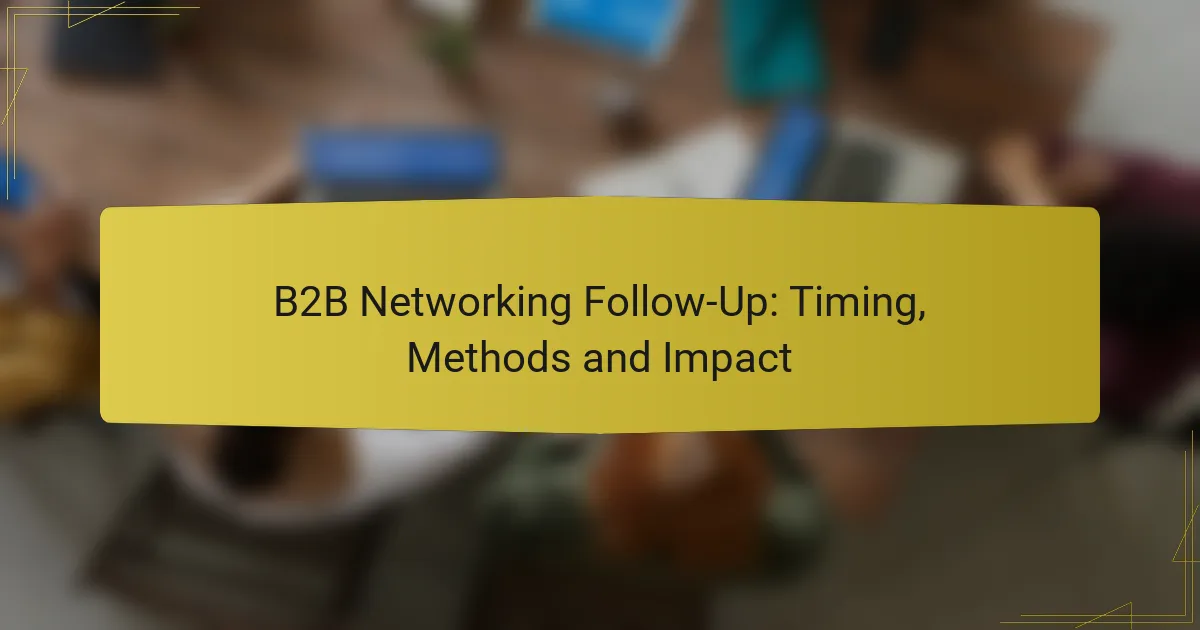Following up after B2B networking is essential for maintaining connections and expressing interest in collaboration. Timely follow-ups, ideally within a few days, can significantly enhance relationship-building efforts. Utilizing various methods such as email, phone calls, and social media engagement allows for tailored communication that can strengthen partnerships and create new opportunities.
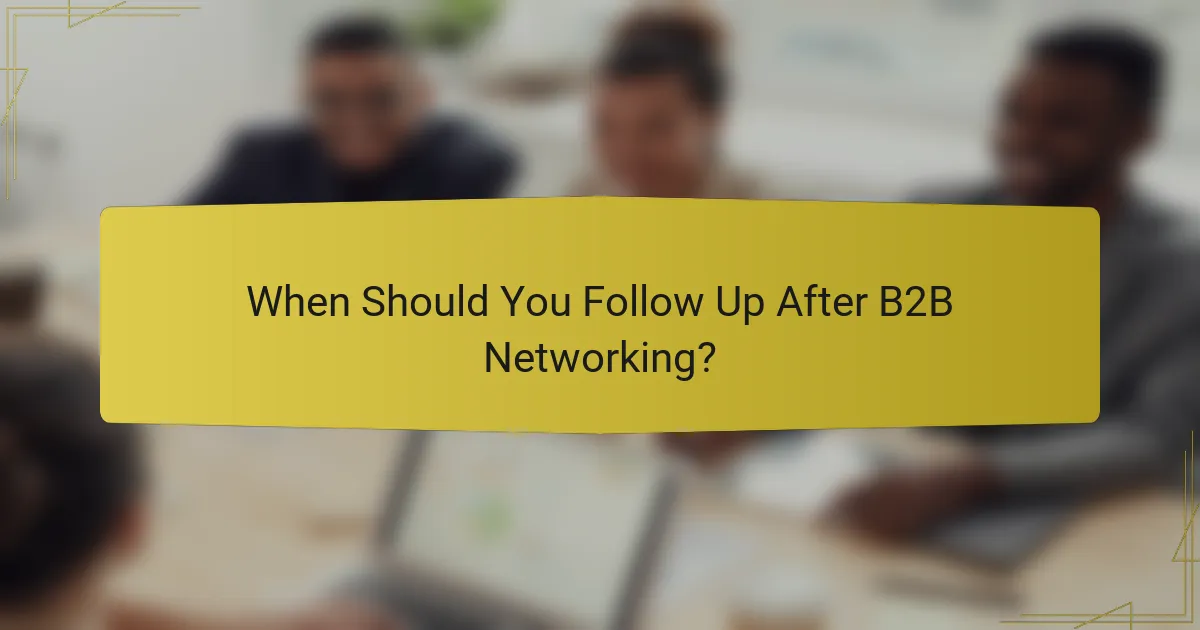
When Should You Follow Up After B2B Networking?
Following up after B2B networking is most effective when done promptly, ideally within a few days. This approach helps maintain the connection and reinforces your interest in collaboration.
Optimal timing is within 24-48 hours
The best time to follow up is within 24 to 48 hours after the networking event. This timeframe keeps your conversation fresh in both parties’ minds and shows your enthusiasm. A quick email or message can significantly enhance the likelihood of a positive response.
Delaying your follow-up beyond this window may result in diminished interest or forgotten details. Aim to send your follow-up while the interaction is still relevant and memorable.
Consider follow-up timing based on event type
Different networking events may require different follow-up strategies. For instance, after a formal conference, a follow-up email may be appropriate, while a casual meet-up might warrant a quick text or social media message. Tailoring your approach based on the event type can improve engagement.
Additionally, consider the time of day and week for your follow-up. Sending messages during business hours on weekdays typically yields better responses than late-night or weekend communications.
Use calendar reminders for follow-ups
To ensure timely follow-ups, set calendar reminders immediately after networking events. This simple step helps you stay organized and accountable, preventing missed opportunities. Use digital tools or apps that send notifications to keep your follow-up tasks on track.
Consider creating a follow-up schedule that includes specific dates and methods for reaching out. This structured approach can help you manage multiple connections effectively and maintain a consistent networking strategy.
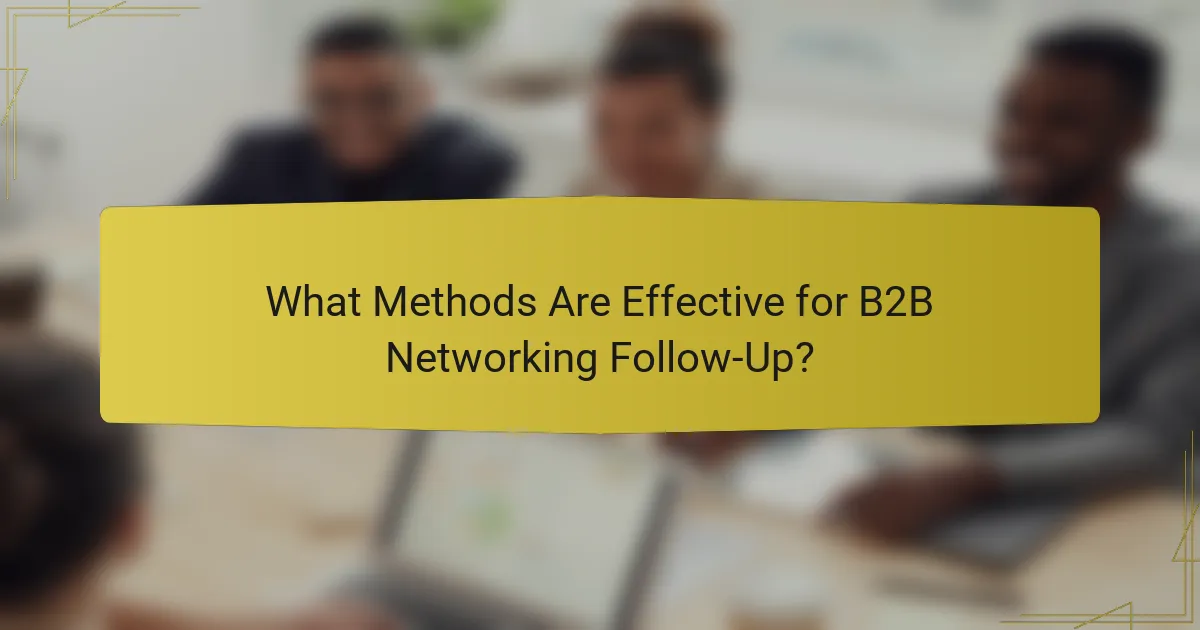
What Methods Are Effective for B2B Networking Follow-Up?
Effective methods for B2B networking follow-up include email, phone calls, social media engagement, and utilizing LinkedIn. Each method has its strengths and can be tailored to fit the relationship and context of the initial interaction.
Email as a primary follow-up method
Email remains a cornerstone for B2B networking follow-up due to its convenience and formality. A well-crafted email can summarize discussions, share resources, or propose next steps, making it an ideal choice for maintaining professional relationships.
When composing follow-up emails, aim for clarity and brevity. Personalize your message by referencing specific points from your previous conversation. A good rule of thumb is to send your follow-up within 24 to 48 hours after the initial meeting.
Phone calls for personal touch
Phone calls can provide a personal touch that emails often lack, making them effective for deeper engagement. A quick call can clarify any misunderstandings and reinforce your interest in collaboration.
When making follow-up calls, prepare key points in advance to keep the conversation focused. Aim for a call duration of 5 to 10 minutes to respect the other person’s time while allowing for meaningful dialogue.
Social media engagement strategies
Social media platforms offer unique opportunities for B2B networking follow-up. Engaging with contacts through comments, shares, or direct messages can keep you on their radar and foster ongoing dialogue.
Consider sharing relevant articles or insights that align with your contacts’ interests. Regular interaction can help build rapport, but avoid overwhelming them with excessive messages or posts.
Utilizing LinkedIn for professional connections
LinkedIn is a powerful tool for B2B networking follow-up, allowing you to connect with professionals in your industry. Sending a personalized connection request can help solidify the relationship established during your initial meeting.
Once connected, engage with their content by liking or commenting on posts. Additionally, you can use LinkedIn’s messaging feature to send follow-up notes, share updates, or propose meetings, ensuring your presence remains strong in their professional network.

How Does Follow-Up Impact B2B Relationships?
Follow-up is crucial in B2B relationships as it solidifies connections and opens doors for future opportunities. Effective follow-up can lead to stronger partnerships, increased collaboration, and a positive perception of your brand.
Strengthens professional connections
Regular follow-up helps maintain and deepen professional relationships. By reaching out after initial meetings or events, you demonstrate commitment and interest, which fosters trust and rapport.
Consider scheduling follow-ups within a week of your last interaction. This keeps the conversation fresh and shows that you value the relationship. Simple gestures, such as sending a thank-you email or sharing relevant resources, can significantly enhance your connection.
Increases chances of collaboration
Following up can create opportunities for collaboration by keeping your business top-of-mind. When you express interest in a potential partner’s projects or initiatives, you open the door for joint ventures or shared goals.
To maximize collaboration chances, tailor your follow-up to address specific interests or needs discussed previously. Propose actionable ideas or suggest a follow-up meeting to explore synergies, which can lead to mutually beneficial projects.
Enhances brand perception
Consistent follow-up can significantly enhance how your brand is perceived in the market. When you engage thoughtfully with clients and partners, it reflects professionalism and reliability.
To improve brand perception, ensure your follow-up communications are timely and relevant. Use personalized messages that resonate with the recipient’s interests. Avoid generic templates, as they can diminish the impact of your outreach.
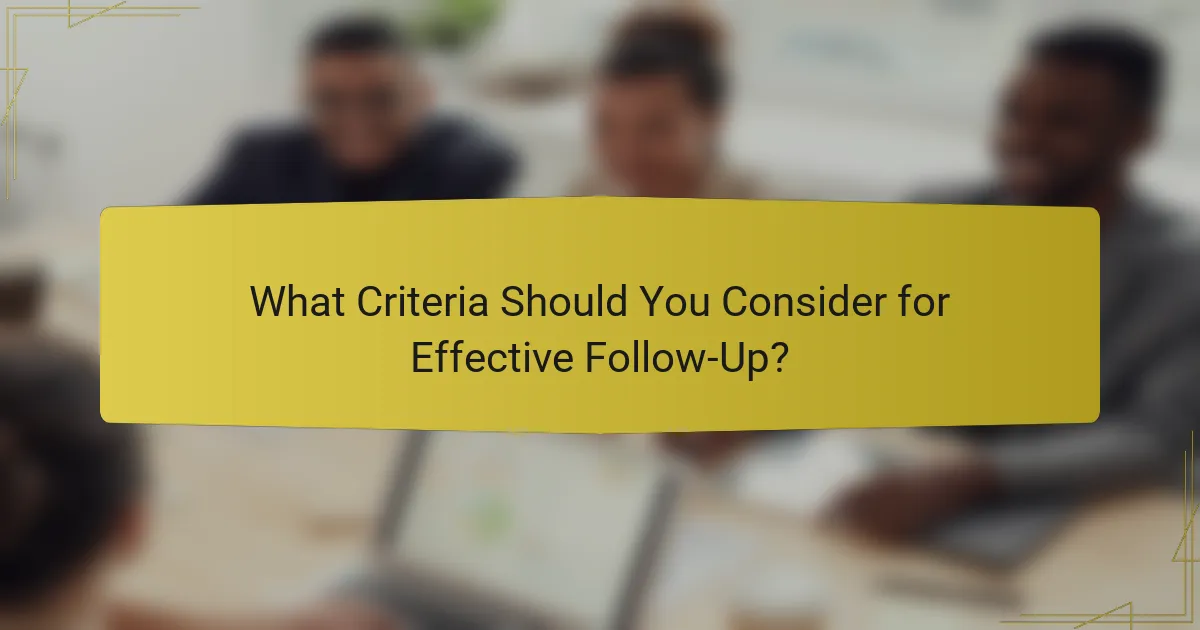
What Criteria Should You Consider for Effective Follow-Up?
Effective follow-up in B2B networking hinges on several key criteria, including the personalization of messages, the relevance of the initial conversation, and the frequency of follow-ups. These factors can significantly influence the success of your outreach efforts and help maintain strong business relationships.
Personalization of messages
Personalizing your follow-up messages is crucial for making a lasting impression. Tailor your communication to reflect the specific interests and needs of the recipient, referencing details from your previous conversation. This approach shows that you value their time and are genuinely interested in their business.
For instance, if you discussed a particular challenge they face, mention it in your follow-up and suggest a relevant solution. Using the recipient’s name and company can also enhance the personal touch, making your message stand out.
Relevance of the initial conversation
The relevance of your initial conversation plays a significant role in shaping your follow-up strategy. Ensure that your follow-up aligns with the topics discussed and addresses any questions or concerns raised during your meeting. This demonstrates attentiveness and reinforces your commitment to the relationship.
Consider summarizing key points from your initial discussion in your follow-up message. This not only refreshes their memory but also provides a clear context for your outreach, making it easier for them to engage with your content.
Follow-up frequency
Determining the right frequency for follow-ups is essential to avoid overwhelming your contacts. A good rule of thumb is to follow up within a week of your initial meeting, then space subsequent messages out over a few weeks or months, depending on the relationship and context.
Be mindful of the recipient’s response patterns. If they engage positively, you might increase the frequency of your follow-ups. Conversely, if they seem unresponsive, consider reducing the frequency to avoid coming across as pushy. A simple checklist can help you track your follow-up schedule:
- Follow up within 1 week of the initial meeting.
- Space out additional follow-ups by 2-4 weeks.
- Adjust frequency based on recipient engagement.
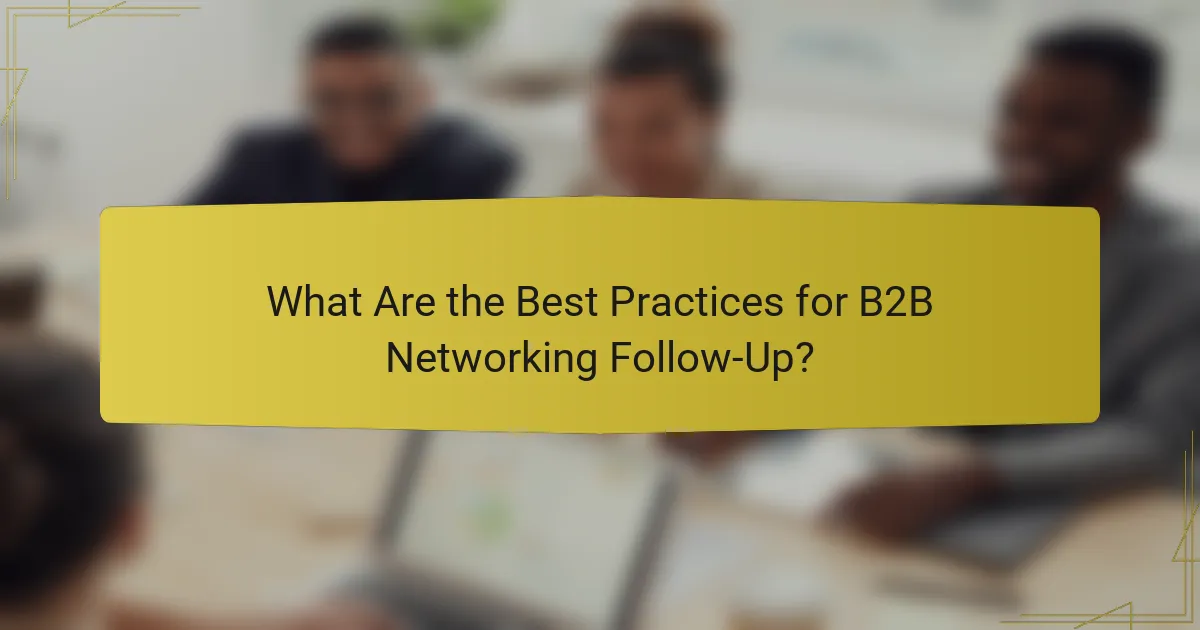
What Are the Best Practices for B2B Networking Follow-Up?
Effective B2B networking follow-up is crucial for building relationships and converting leads into clients. Best practices include timely communication, clear messaging, and setting specific objectives to enhance engagement.
Crafting a clear and concise message
When following up, your message should be straightforward and to the point. Avoid jargon and focus on the key takeaways from your previous interaction, reminding the recipient of your conversation’s highlights.
For example, start with a friendly greeting, reference your last meeting, and clearly state the purpose of your follow-up. This could be sharing additional information, scheduling a call, or addressing any questions they may have.
Setting specific follow-up goals
Establishing clear goals for your follow-up can significantly enhance its effectiveness. Define what you want to achieve, whether it’s securing a meeting, obtaining feedback, or nurturing a lead.
Consider using the SMART criteria—Specific, Measurable, Achievable, Relevant, and Time-bound—to set your goals. For instance, aim to schedule a follow-up meeting within a week rather than a vague “let’s catch up sometime.”
Tracking follow-up interactions
Keeping track of your follow-up interactions is essential for maintaining organization and ensuring timely responses. Utilize a CRM system or a simple spreadsheet to log your communications, noting dates, topics discussed, and next steps.
Regularly review your follow-up history to identify patterns and adjust your approach as needed. This will help you stay proactive and ensure no potential opportunity slips through the cracks.

How Can Technology Enhance B2B Networking Follow-Up?
Technology can significantly improve B2B networking follow-up by streamlining communication and automating processes. Tools like CRM systems, email marketing platforms, and social media can help maintain connections and manage relationships effectively.
Utilizing CRM Systems
Customer Relationship Management (CRM) systems are essential for tracking interactions with potential and existing clients. They enable businesses to store contact information, log communication history, and set reminders for follow-ups. This organized approach ensures that no opportunity is missed.
When selecting a CRM, consider factors like ease of use, integration capabilities, and cost. Popular options include Salesforce, HubSpot, and Zoho, which cater to various business sizes and budgets.
Email Automation Tools
Email automation tools can enhance follow-up efficiency by scheduling messages and personalizing content based on recipient behavior. These tools allow businesses to send timely reminders or thank-you notes after networking events, keeping the conversation alive.
Examples of effective email automation tools include Mailchimp and ActiveCampaign. They offer features like segmentation and analytics, helping businesses refine their outreach strategies based on engagement metrics.
Leveraging Social Media Platforms
Social media platforms are powerful tools for B2B networking follow-up, allowing businesses to engage with contacts in a more informal setting. Platforms like LinkedIn facilitate professional connections and provide opportunities for sharing valuable content and insights.
To maximize social media’s impact, regularly post updates, comment on industry news, and engage with your network’s content. This consistent interaction can strengthen relationships and keep your brand top-of-mind.
Implementing Virtual Meeting Tools
Virtual meeting tools, such as Zoom or Microsoft Teams, are crucial for maintaining face-to-face interactions in a digital world. These platforms enable businesses to conduct follow-up meetings, webinars, or presentations, enhancing personal connections despite geographical barriers.
When using virtual meeting tools, ensure you have a reliable internet connection and a quiet environment. Prepare an agenda to keep meetings focused and productive, and follow up with a summary of key points discussed to reinforce the relationship.
